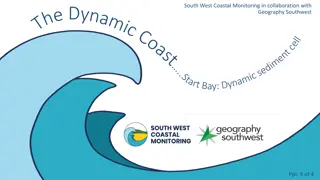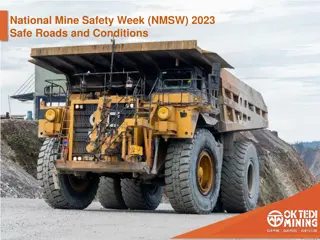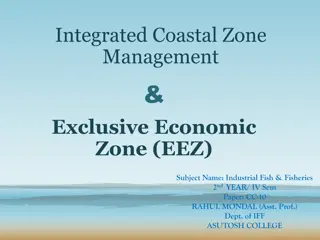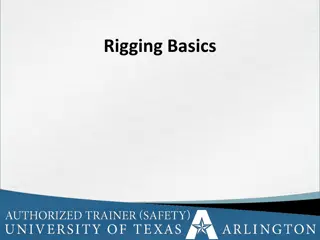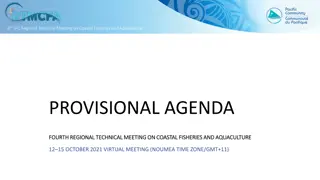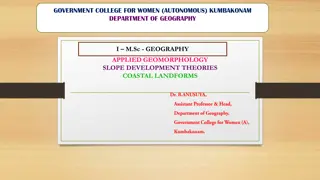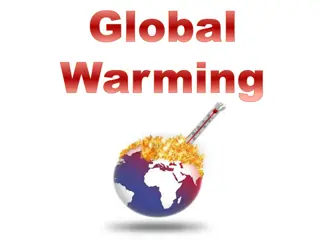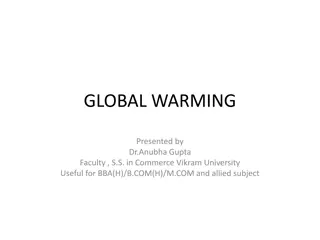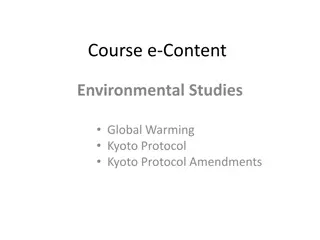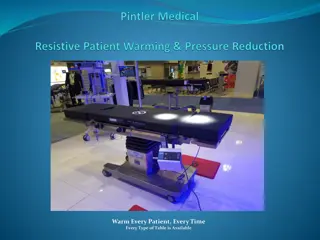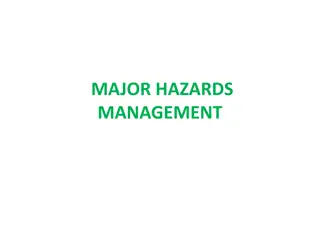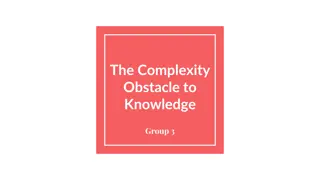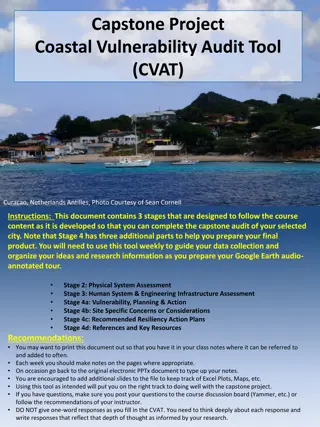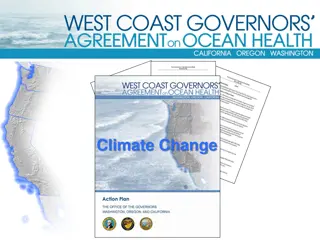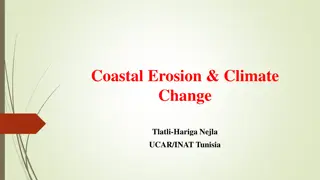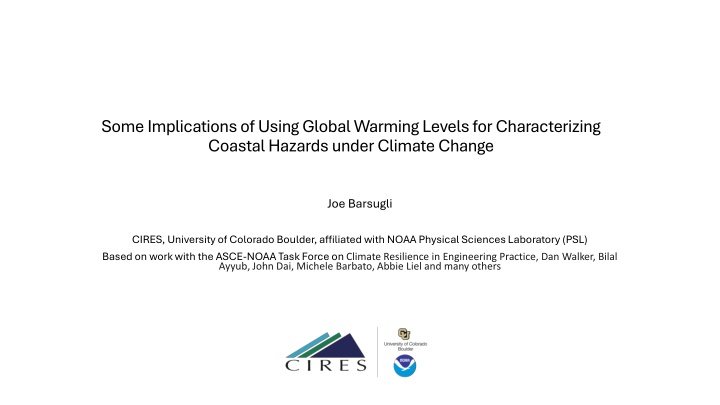
Implications of Global Warming Levels on Coastal Hazards
Using Global Warming Levels to characterize coastal hazards under climate change is crucial for engineering resilience. Explore the concept of Global Warming Levels, their relevance to regional changes, and how they compare to emissions scenarios. Understand the uncertainty involved and the importance of incorporating GWL in climate assessments.
Download Presentation

Please find below an Image/Link to download the presentation.
The content on the website is provided AS IS for your information and personal use only. It may not be sold, licensed, or shared on other websites without obtaining consent from the author. If you encounter any issues during the download, it is possible that the publisher has removed the file from their server.
You are allowed to download the files provided on this website for personal or commercial use, subject to the condition that they are used lawfully. All files are the property of their respective owners.
The content on the website is provided AS IS for your information and personal use only. It may not be sold, licensed, or shared on other websites without obtaining consent from the author.
E N D
Presentation Transcript
Some Implications of Using Global Warming Levels for Characterizing Coastal Hazards under Climate Change Joe Barsugli CIRES, University of Colorado Boulder, affiliated with NOAA Physical Sciences Laboratory (PSL) Based on work with the ASCE-NOAA Task Force on Climate Resilience in Engineering Practice, Dan Walker, Bilal Ayyub, John Dai, Michele Barbato, Abbie Liel and many others
An Overarching Question How do we characterize future climate(s) in a way that is: Scientifically justified Usable within the capacity of practicing engineers *Simple enough to be adopted into engineering standards Easy to communicate with clients particularly regarding risks vs. costs Durable (given long life cycles of standards and code adoption) Options Emissions scenario/time period (e.g. RCP8.5 in 2050; SSP370 in 2080-2100) Global Warming Level (e.g. 3C global mean temperature above pre-industrial) https://repository.library.noaa.gov/view/noaa/50897
What is Global Warming Level (GWL)? GWL is the change in globally averaged temperature temperature relative to a baseline period Global Mean Surface Temperature (GMST) near-surface (2m) air temperature over land and ice, and sea- surface temperature over oceans (typically) Global Mean Surface Air Temperature (GMSAT or GSAT) We are currently at ~ 1.1 1.2 C above the 1850-1900 baseline Source: NOAA Climate at at Glance 1850-1900 climate baseline period typical, but others used ( pre-industrial , 1901-2000) Baseline shifts are easy--just add or subtract Moving average typically 20 years -- to lessen fluctuations due El Ni o, random weather effects, etc. IPCC AR6: GWL is an integrating dimension underlying model simulations and scenarios are the foundation, but GWL is used to filter/align according to the GWL
What does GWL mean for regional/local changes? Many local and regional climate variables scale with change in GSAT. For fast-response variables, the changes are mostly independent of WHEN For SLR and other variables where the rate of change scales with GWL, so a time frame is needed as well.
GWL vs. Emissions Scenario Approach Global Regional/Local The GWL approach does not eliminate uncertainty compared to using Emissions Scenarios, but it refactors it 4C 3C Prob(GWL) * Prob( Xlocal)|GWL) 2C The Cascade of Uncertainty Adapted from Wilby and Dessai (2010)
Potential Advantages More tractable treatment of uncertainty Physical quantity that will outlast specific scenario names and definitions (SRES -> RCP -> SSP -> ??? -> ??? ) Global policy aimed at GWLs -- 2 C, 1.5 C -- we are steering the ship Deep uncertainty in time planning for beyond 2100 Alignment of climate hazards from disparate sources Easier to communicate? hot models in CMIP6 ASCE7-28 Chapter 36 ( Future Conditions ) is currently considering using GWL approach where possible 3 C by 2100 (or a variant of this) Caveats Relatively new approach for climate adaptation -- not everything may scale well. Nonlinear effects/rapid transitions (snow loads?) Cases where specific time evolution matters Locations where strong regional anthropogenic forcing is important (aerosols, black carbon)
Why am I talking about this in a session on Sea Level Rise? One of the first major climate adaptation documents to adopt GWL as an integrating dimension for its long-term (post-2050) projections As in 2017 report, local and regional SLR projections are keyed off of global mean SLR projections. 2022 Report uses GWL in 2081-2100 period to filter the global SLR projections that are the basis for the regional SLR projections. updated temporal trajectories and exceedance probabilities now based on global warming levels rather than emissions scenarios.
SLR Report Table 2.4 Let s take some time to look at this and see how this illustrates the previous points.
Aligning Climate Hazards This will allow alignment of multiple hazards in a manner consistent with climate science Precipitation extremes Wind extremes - in particular, tropical storm/hurricane Temperature extremes Riverine flooding Urban flooding Are we there yet? Not really most climate datasets (particularly downscaled datasets) still use scenario/time as integrating dimension NOAA Atlas 14->15 transition is being requested to offer GWL as integrating dimension Vetting during ASCE7-28 process
Questions What benefits do YOU see in using GWL approach to describe future design climates compared to the traditional Emissions Scenario (RCP/SSP) approach? What drawbacks? What impediments to using this approach? If this approach were adopted in ASCE standards what considerations would you like to see?
Further Reading 2022 Interagency Sea Level Rise Technical Report Sweet, W.V., B.D. Hamlington, R.E. Kopp, C.P. Weaver, P.L. Barnard, and co-Authors, 2022: Global and Regional Sea Level Rise Scenarios for the United States: Updated Mean Projections and Extreme Water Level Probabilities Along U.S. Coastlines. NOAA Technical Report NOS 01. National Oceanic and Atmospheric Administration, National Ocean Service, Silver Spring, MD, 111 pp. IPCC AR6 Technical Summary section Arias, P.A., N. Bellouin, E. Coppola, R.G. Jones, G. Krinner, and co-Authors, 2021: Technical Summary. In Climate Change 2021: The Physical Science Basis. Contribution of Working Group I to the Sixth Assessment Report of the Intergovernmental Panel on Climate Change [Masson- Delmotte, V., P. Zhai, A. Pirani, S.L. Connors, and co-Editors (eds.)]. Cambridge University Press, Cambridge, United Kingdom and New York, NY, USA, pp. 33 144. doi: 10.1017/9781009157896.002. ASCE-NOAA Workshop Report: More on Carbon Budget Approach: Matthews, H. D. et al. Opportunities and challenges in using carbon budgets as a guide for climate policy. Nat. Geosci. 13, 769 779 (2020).
What is GWL? What is Global Warming Level? Global average (near-)surface air temperature has increased by about 1.1-1.2 since the 1850-1900 baseline and is projected to increase further by the end of the century. For each emissions scenario there is an overlapping range of global warming levels. Adapted from IPCC AR6 Technical Summary Figure TS.8 Changes shown relative to 1995-2014 baseline

